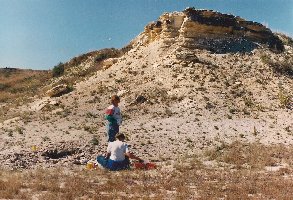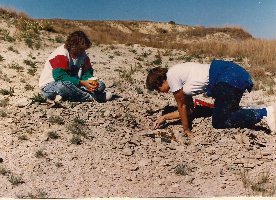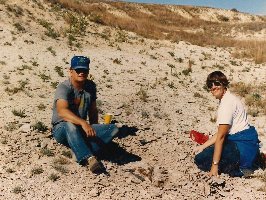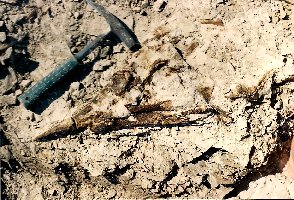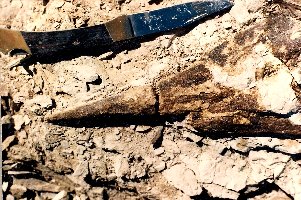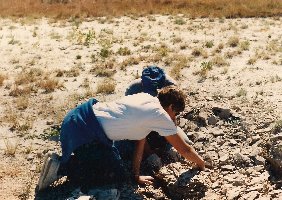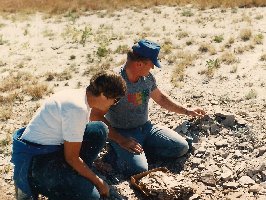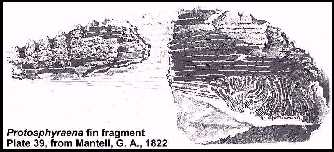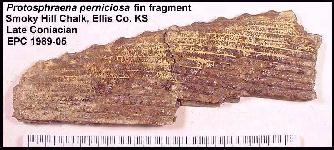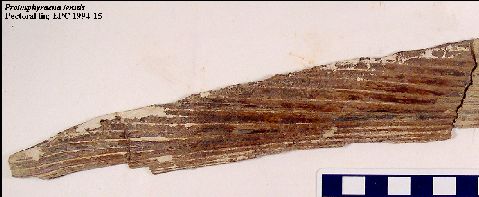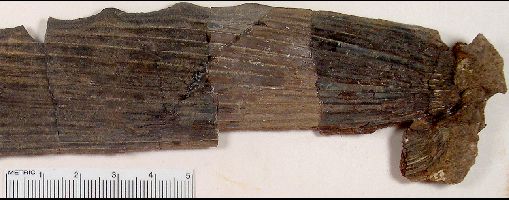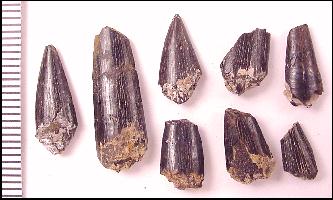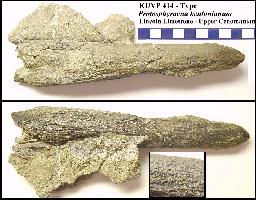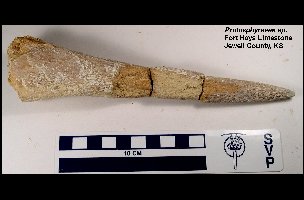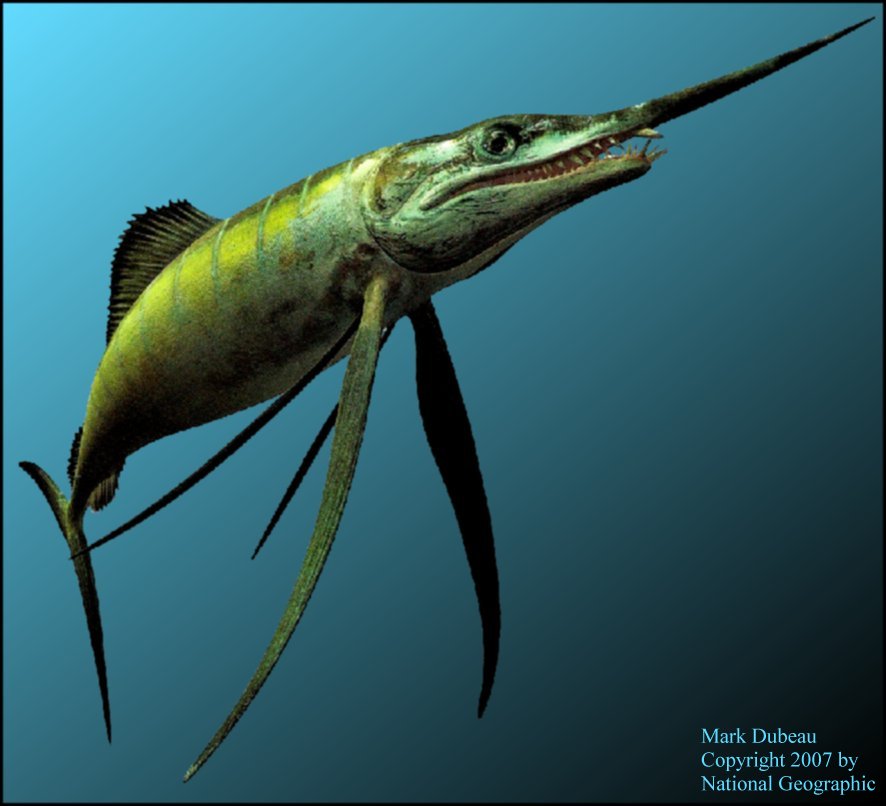 |
Protosphyraena:
A Late Cretaceous pachycormid
"Swordfish"
Copyright © 2002-2012 by Mike Everhart
Page created 11/19/2002; Updated
02/12/2012
LEFT: "Protosphyraena"
by Mark Dubeau; adapted from the figure on page 96 in my 2007 book - Sea
Monsters; Prehistoric Creatures of the Deep. Copyright National
Geographic |
| Charles
Sternberg imagined that his "snout-fishes" were among the most
dangerous fish in the Western Interior Sea. While that view is probably incorrect, they
were certainly among the strangest of the large predatory fishes during the Late
Cretaceous. “… I
used to think that the man-eating sharks off the Florida coast were the most blood-thirsty
of the order, but this one is still worse. Notice the head is prolonged in front into a
long round bony snout, or ram. On account of this, I called it a snout fish, when I first
discovered their bones in the Kansas Chalk. The ram ends, you notice, in a sharp point
eight or ten inches long. Then at the end of the mouth there are four lance-like teeth
projecting forward and outward. The object of these is to cut wider the breach his ram
makes in the quivering flesh of a mosasaur, so he can force his head into the bleeding
flesh to the eye rims. But his most terrible weapons are his pectoral fins. See, they are
four feet long, serrated on the cutting or outer edge, enameled, and as sharp as a knife.
They can be locked, and stand out straight from the body. A sudden swing would, if he was
close to a mosasaur, cut a gash several feet long in its vitals. See these fins span over
eight feet. I pity the fish or reptile that comes his way."
Excerpted from Charles H. Sternberg's "Hunting Dinosaurs on
the Red Deer River, Alberta, Canada" (1917, p. 167-168). |
The genus Protosphyraena is
represented by the remains of several fairly common fish found in the Smoky Hill Chalk and
elsewhere around the world (Europe, Japan). It would have looked somewhat like a modern
swordfish with a sharp, sword-like beak and long, sickle shaped front fins. The teeth were
first described from the English chalk by Mantell and the genus was named by Leidy in 1857
from English specimens.
The first specimens of Protosphyraena from Kansas were apparently
collected by B. F. Mudge near the Solomon River (Rooks County) in 1872-73 and sent to E.
D. Cope who named them. Cope's original genus name (Erisichthe) was later
determined to be a junior synonym of Leidy's Protosphyraena. Protosphyraena
nitida and P. gladius were named in 1873, followed by Ichthyodectes
perniciosus (= Protosphyraena perniciosa) in 1874.
Cope described the fin of I.
perniciosus as: "The cutting edge is coarsely serrate, each
projecting tooth marking the end of one of the oblique component rods [pectoral fin
spines]. The apex of each tooth is the end of a transverse thickening or low ridge of the
surface of the spine, so that the cutting edge is equally acute at the bottoms of the
concavities as at the rather obtuse apices of the teeth."
The incorrect spelling of the species name, "pernicosa"
in recent publications (including a number of mine in the past) is the subject of some
concern because it was not officially changed, and should remain "perniciosa."
The original spelling authored by Woodward (1895, p. 414) is used here.
The Name Game
Cope (1874, p. 41) gave the name Ichthyodectes perniciosus
Cope (1875, p. 244) changed
the name to Pelecopterus perniciosus (male gender)
Woodward (1895) changed the name to Protosphyraena perniciosa
(female gender)
Loomis (1900, p. 221) mentions the species as Protosphyraena perniciosa
Hay (1903, p. 9) discusses the species as Protosphyraena perniciosa.
J. D. Stewart (1979, 1988 and 1990) spelled the
species name: P. pernicosa… This spelling
has been repeated in a number of papers by other authors, including myself, since
1990. |
B. F. Mudge (1874, p. 122) wrote: “The
most remarkable species of fish which we have found, the present season, are of a genus
new to me, and I think to science. They are armed with a long, strong weapon at the
extremity of the upper jaw, something like that of a sword-fish, but round and pointed and
composed of strong fibres. The jaws are provided with three kinds of teeth. On the outer
edge is a row of large, flat, cutting teeth, somewhat resembling those of a shark. Inside,
and placed irregularly, are small, blunt teeth; while in the back portion of the palate is
the third set- small, sharp and needle-like in shape, forming a pavement. The jaws are
also fibrous, like the snout. There are three species of this genus. Prof. Marsh has them
for critical scientific examination.”
Apparently, at least fourteen
specimens (YPM 42152, 42200, 42285, 42137, 42138, etc.) were collected by Mudge in
1874 from Ellis and Rooks counties... and never reported by Marsh.
P. perniciosa grew to fairly large size (est. 3 m) while others (P.
nitida and P. tenuis) were smaller (2 m or less). Another rare, giant
"species named" Protosphyraena gladius is not actually be a member of the
genus (and below). An other species named by Cope, Erisichthe ziphioides 1877, was
determined to be a completely new and unrelated genus (Martinichthys)
which was described by McClung in 1926, and revised by Taverne (1999).
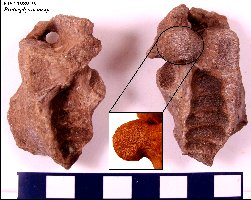 |
LEFT: A pair of Protosphyraena coracoid bones from
the Smoky Hill Chalk. These distinctive shoulder bones
and the pectoral fins are most frequently preserved
as fossils of this genus, and in several species (P. perniciosa and P. tenuis)
the fins have a distinctive saw-toothed, leading edge.
Partial skulls, with a sharp rostrum (nose) is also found preserved in the chalk and is
readily recognized by the flat, blade-like teeth. The
anterior teeth in the upper and lower jaws point forward. The remaining skeleton was
poorly ossified and has not been found preserved, except for the hypural bone at the base of the caudal fin. Two specimens at
the University of Kansas do preserve a nearly complete caudal fin (KUVP-293 and
KUVP 49419:
below): |
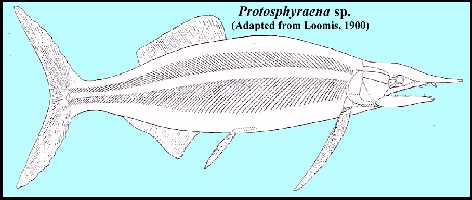 |
LEFT: This is what Frederick Loomis (1900)
thought that Protosphyraena looked like. Although it is incorrect in
several aspects, including the tail, we have learned very little more about the appearance
of this strange fish in the last 100 years. ... until recently, that is. |
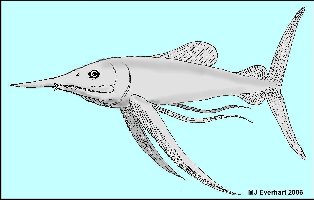 |
LEFT: My sketch at left is probably much closer to the actual
appearance of Protosphyraena perniciosa than the one by Loomis (above). It is based on a recent discovery by Mike Triebold
(LEFT)in the Smoky
Hill Chalk of Gove County. The specimen is currently on display in the Rocky Mountain Dinosaur Resource Center in Woodland Park, Colorado.
Although lacking the anterior portion of the skull, it is the most complete specimen of Protosphyraena
ever found, and provides valuable information regarding the unusual characteristics
of this fish. The fish is rather short for the size of it's long, saw-toothed
pectoral fins and large nearly vertical caudal fin. The pelvic fins are long and
streamer-like, and emerge just behind the pectoral fins. The dorsal fin is large and
rounded. Both the second dorsal fin and the anal fin are rounded, and are located just anterior to the caudal fin. Their position suggests that
they served to enlarge the surface area of the tail and possibly provide additional thrust
for fast swimming.
See
more colorful reconstructions of Protosphyraena perniciosa and P.
nitida by Dmitry Bogdanov here:
|
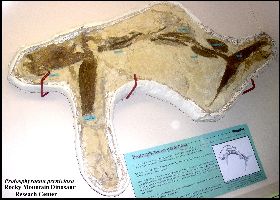 |
PROTOSPHYRAENA NITIDA - Protosphyraena
nitida was a primitive predatory fish that looked something
like a modern swordfish, but did not have well ossified vertebrae. It
was somewhat smaller than P. perniciosa. To date, this is
the only known specimen of Protosphyraena nitida which has the pectoral fins preserved
with the skull. The specimen below was donated to the Los Angeles
County Museum of Natural History and a picture of the right side of the prepared
skull was published in the LACMNH Magazine, TERRA, in 1993 (Vol. 31,
Number 4). A cast of the skull was exhibited in the Denver Museum of
Natural History, in the Ray Troll traveling exhibit in 1998. Pictures of our
cast of the skull are HERE
and HERE.
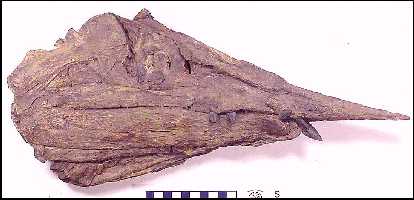 |
LEFT: The right (lower) side of
a cast of the skull of Protosphyraena nitida (LACM 129752). The
oversized front tooth was added for the casting.
RIGHT: The left (upper) side of
a cast of the skull of Protosphyraena nitida (LACM 129752). The
oversized front tooth was added for the casting.
|
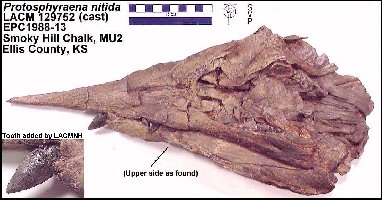 |
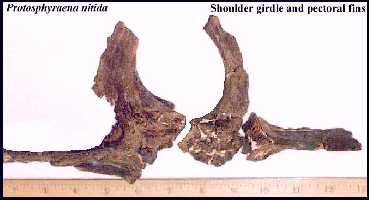 |
LEFT: An anterior view of the scapulo-coracoids
and attached (but incomplete) pectoral fins of the P. nitida specimen. (From a
1988 photograph)
RIGHT: This photo shows the "articulation" between the
shoulder girdle (scapulo-coracoid) and the back of the skull as found. In life, they would
not have been attached to the skull, but located just behind it. The two incomplete
pectoral fins point off to the top right and mid-right of the photograph. |
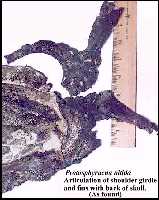 |
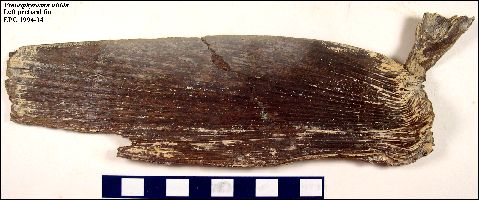 |
LEFT: FHSM VP-17561 - Protosphyraena nitida
fins do not have the jagged, saw-toothed edges found in P.
perniciosa. Instead they have fine grooves at right angles to the edge of the fin
(CLICK HERE FOR CLOSE-UP). (EPC
1994-04) |
 |
LEFT: FHSM VP-17562 - An associated partial skull and
pectoral fin of a very small (about 3 ft or 1 m) Protosphyraena nitida (EPC
2003-14) that I collected in the lower chalk of southeastern Gove County (2003). This
specimen is unusual both for the small size and the association of a rostrum with a
pectoral fin. The specimen shows evidence of being scavenged by a shark, probably Squalicorax
falcatus. |
PROTOSPHYRAENA PERNICIOSA
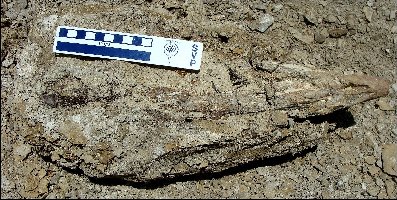 |
LEFT: In May, 2010, I discovered this skull of
Protosphyraena perniciosa eroding from the edge of a gully. The
rostrum (bill) had already broken off and rolled down the slope. After
removing enough matrix from around the specimen to put it up on a pedestal,
I went back to the van to get the necessary materials (water, paper
towels, aluminum foil and plaster bandages) to put a jacket on the
skull. |
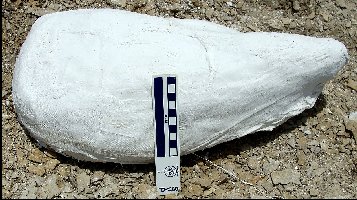 |
LEFT: Once the jacket was completed, I had to let it
dry. Then I rolled it over and removed the excess matrix. |
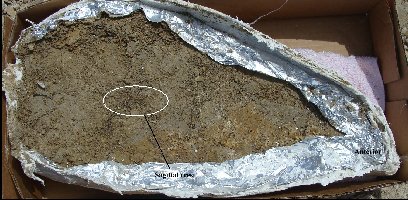 |
LEFT: The matrix is carefully removed down to a point
where the first bit of bone is encountered, in this case, the sagittal
crest of the skull (white oval). This lowered the weight of the jacket
significantly and made it much easier to carry about a quarter mile up the
slope to my van. |
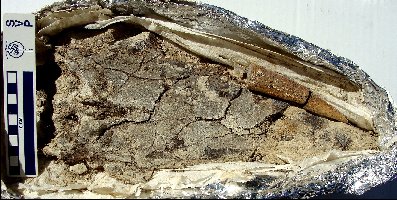 |
LEFT: It had been raining for a few days before I
collected the specimen. The chalk was pretty damp around the bones and
needed to dry a little before I would be able to work on it. After letting the specimen dry out for a couple of
days, I removed the remaining matrix over the top of the skull. The bones
are broken and there is some root damage, but otherwise the skull is in
excellent condition. |
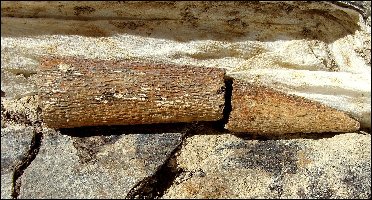 |
LEFT: This is the broken end of the rostrum (bill) of
this specimen. They were the first recognizable pieces I saw before
locating the skull. Note the distinctive patterning on this bone. |
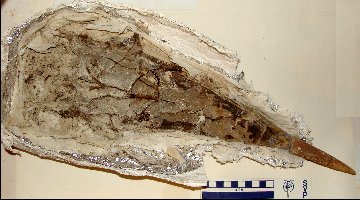 |
LEFT: The partially prepared skull re-assembled to show
the position of the rostrum (sword). The skull is 17.5 in (44.5 cm) long.
It has been donated to the Sternberg Museum of Natural History (FHSM
VP-17600) |
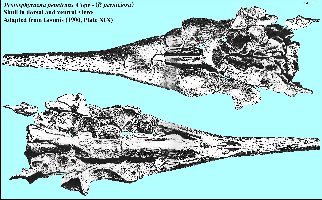 |
LEFT: The skull of Protosphyraena perniciosa in
dorsal and ventral views. Adapted from Loomis (1900, Plate XIX).
Abbreviations for labels on bones: Eth. =
Ethmoid; Eth. Lat. = Ethmoid laterale; Fr. = Frontal; Sq. = Squamosal; Psp.
= Parasphenoid; Osp.
= Orbitosphenoid; Asp. = Alisphenoid; Prot.
= Prootic; Oot. = Opisthotic; Sot. = Sphenoid; Ptet. = Pterotic;
Bock. = Basioccipital; Eoc. = Exoccipital; Vom. = Vomer.
|
 |
LEFT: A complete set of Protosphyraena perniciosa
fins (FHSM VP-80) that are on exhibit in the Sternberg Museum at Fort Hays State
University, Hays, Kansas. These were collected in the lower Smoky Hill Chalk (late
Coniacian) of Ellis County. Each fin measures over 36 inches, and the complete mount
measures 77 inches across including the pectoral girdle (scapulo-coracoid). |
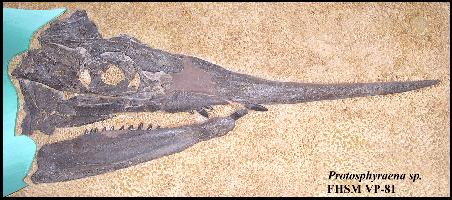 |
LEFT: A complete skull of Protosphyraena sp. (probably P.
perniciosa) that was previously on exhibit in the original Sternberg Museum on the
campus of Fort Hays State University, Hays, Kansas. This specimen (FHSM VP-81) was
collected and prepared by George Sternberg from the chalk of Ellis County, and measures 15
in. (38 cm) from the back of the skull to the tip of the rostrum. Note the forward facing
teeth in both the upper and lower jaws. |
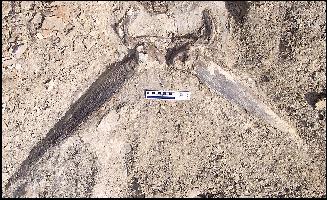 |
LEFT: A field photo of a complete set of Protosphyraena
perniciosa fins and shoulder girdle (scapulo-coracoids) found by Pam Everhart in the
lower chalk of Trego County, in 2004. |
 |
LEFT: The anterior portion of another Protosphyraena
skull in my collection, showing the long rostrum. This particular specimen shows evidence of scavenging by sharks, probably Squalicorax.
|
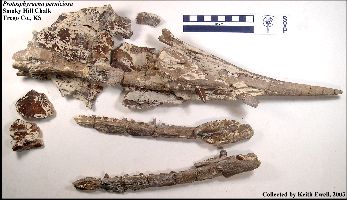 |
LEFT: A Protosphyraena perniciosa
(FHSM VP-17573)
skull and
lower jaws in right lateral view. This nearly complete skull was found by Keith Ewell in
the lower Smoky Hill Chalk (Late Coniacian) of western Trego County in 2003.
Unfortunately, most of the skull had weathered out sometime earlier and all but one of the
larger teeth were damaged by erosion. However, the smaller teeth on the coronoid bones at
the anterior end of the lower jaws were preserved largely intact: Anterior ends of lower jaws; Left dentary; Left dentary; right dentary; right dentary. |
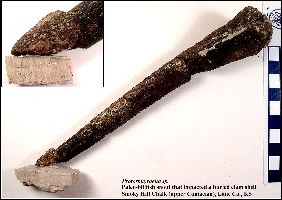 |
LEFT: Fractured rostrum of a Protosphyraena skull that
impacted the bottom at a high rate of speed and buried itself several inches deep
in the chalky mud before
hitting a buried, long-dead clam shell. RIGHT: Dorsal and ventral views
of the same rostrum showing the fractures and deformation that probably occurred during
the process of preservation, not as a result on impact on the clam shell. |
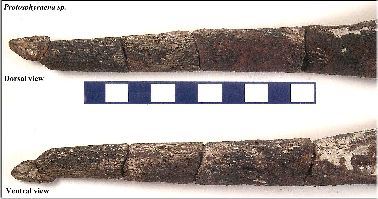 |
PROTOSPHYRAENA TENUIS LOOMIS 1900
Protosphyraena tenuis is a bit problematic. Outwardly, it appears that
the saw-toothed edges of the pectoral fins are less pronounced than in P. perniciosa.
According to J.D. Stewart (pers. comm., 1994) the teeth are also much thinner, exhibiting
less of a vertical bulge on the leading edge of the fin. This is not a readily
quantifiable characteristic and over the years I have tended to believe that they are
actually variations within the same species.
BONNERICHTHYS GLADIUS (COPE 1873)
A fourth (and a very large) species of "Protosphyraena"
found in the Smoky Hill Chalk is P. gladius (Cope, 1873). According to
Stewart (1988) the fins of this species have some distinct characteristics that may set P.
gladius apart from other species of Protosphyraena. In addition, the skull
of P. gladius was unknown, so it was not certain that it even had the sword-like
rostrum typical of P. perniciosa, P. nitida and P. tenuis. A
discovery made in 2003, however, showed that this genus was, instead, a giant filter-feeding (planktivorous)
pachycormid. It was redescribed and renamed as Bonnerichthys gladius by
Friedman et al. (2010).
 |
LEFT: Figure 3, Plate LII from Cope (1875) showing the pectoral
fin of Bonnerichthys gladius, collected by B.F. Mudge from the Smoky Hill Chalk
along the Solomon River in Rooks County, Kansas, and first described by Cope in 1873. (The
anterior edge is at the bottom). |
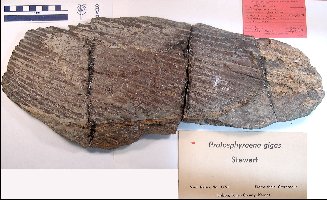 |
LEFT: The type specimen of "Protosphyraena
gigas" Stewart 1899 (KUVP 338) from the Sharon Springs Member of
the Pierre Shale, Logan County, KS. In this case, however, it is actually
one of the few Kansas specimens of Bonnerichthys gladius from the
Pierre Shale.
Stewart, A. 1899. Notice of three new Cretaceous
fishes, with remarks on the Saurodontidae Cope. Kansas University
Quarterly 8(3):107-112. |
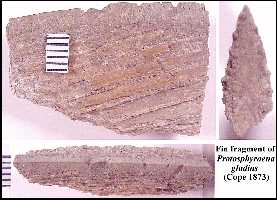 |
LEFT: Although a fair number of specimens of this species have
been collected from as far back as the 1870s (Stewart (1988) lists 17), I have only
collected a small piece of one... the fin fragment shown above left. RIGHT:
This complete pectoral fin (FHSM VP-212) is in the Sternberg Museum collection (88 cm
long, 20 cm wide at the base) and was collected by G.F. Sternberg in 1949. Proximal end of
the fin edge is HERE - Distal tip of fin edge is HERE. |
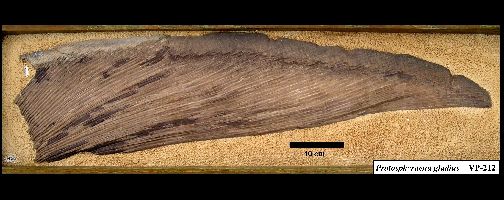 |
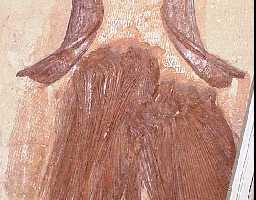 |
LEFT: A pair of fins and associated shoulder (scapulo-coracoid)
elements in the University of Kansas collection are shown at left (KUVP 508). Cope (1875)
remarked that, "This is a formidable weapon, and could be readily used to split wood
in the fossilized condition." Note that Protosphyraena gigas (Stewart, 1899)
is a junior synonym of Bonnerichthys gladius. RIGHT: A
recent discovery (July 2008) of a Bonnerichthys gladius specimen in Gove County. |
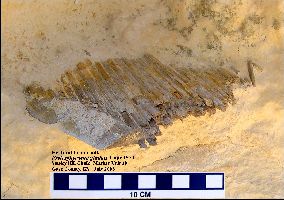 |
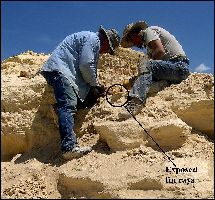 |
LEFT: Mike Everhart and Kenshu Shimada work to remove a block of
chalk containing the large fin (see above right). The block containing the fin is shown HERE
RIGHT: The fin as prepared out of the chalk (Photo by K. Shimada). |
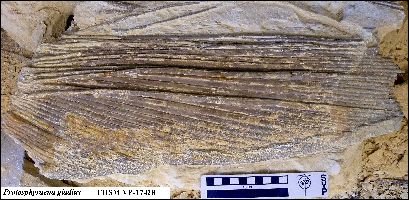 |
55th
SYMPOSIUM OF VERTEBRATE PALAEONTOLOGY AND COMPARATIVE ANATOMY and 16th SYMPOSIUM OF
PALAEONTOLOGICAL PREPARATION AND CONSERVATION - The University of Glasgow. 28th
August - 1st September 2007 (ABSTRACTS, Page
14)
New insights on the Upper
Cretaceous pachycormid ‘Protosphyraena’ gladius (Actinopterygii:
Teleostei) from North America
Matt
Friedman1,
Kenshu Shimada2
and
Anthony Maltese3
1
University of Chicago, Committee on Evolutionary Biology, 1025 E 57th St., Chicago, IL
60637, USA
2
DePaul University, Environmental Science Program and Department of Biological Sciences,
325 North Clifton Avenue, Chicago, Illinois 60614, USA
3
Rocky Mountain Dinosaur Resource Center, 719-686-1820 Woodland Park, CO, USA
'Protosphyraena’
gladius is an
enigmatic pachycormid from the Late Cretaceous of North
America, where
it is known from the Coniacian-Campanian Niobrara chalks and the Campanian Pierre Shale
and Selma Formations. Described remains of this species consist exclusively of pectoral
fins, which can exceed one metre in length. Features of these fins link ‘P.’ gladius
to pachycormids
(Lambers, 1992), but provide no evidence linking it to other species of 'Protosphyraena'. Newly
prepared material of ‘P.’
gladius reveals
details of the skull roof, neurocranium, jaws, hyoid and branchial arches, operculogular
series, and shoulder girdle. These remains indicate that ‘P.’
gladius cannot
be placed within ’Protosphyraena’.
Unlike that genus, ‘P.’
gladius is
edentulous and lacks anterior extension of the rostrodermethmoid into a prominent
rostrum. While ‘P.’
gladius is not
closely related to 'Protosphyraena', it is
very similar to two Jurassic pachycormids: Asthenocormus
and Leedsichthys
(Lambers,
1992). These two taxa
appear to have been ram filter-feeders, and one of them–Leedsichthys–
reached enormous sizes (Liston & Noè, 2004). ‘P.’
gladius also
displays features consistent with filter feeding, and extends the range of this
large-bodied pachycormid clade from the Late Jurassic to the Late Cretaceous. This range
extension also fills a conspicuous ecological gap: no large-bodied filter feeders were
known previously from the Cretaceous. The apparent extinction of this group of
pachycormids at or near the end of the Cretaceous is also intriguing, because it occurs
shortly before the earliest records of large-bodied, ram filter-feeding chondrichthyans
(rhincodontids, cetorhinids, mobulids) in the earliest Paleogene (Shimada, 2007). |
| On a related note, "Ichthypriapus hubbsi"
was the name given to an "odd" bone (KUVP 888) in the University of Kansas
collection by Claude Hibbard (1942) ... he thought it was a clasper from an as then
unidentified chimaeroid fish ... However, it was collected by H.T. Martin in close
association with a large Protosphyraena gladius specimen (KUVP 465)... After he had
prepared it out, Martin labeled it as an "unknown bone." I think it is pretty
safe to assume it is part of the original P. gladius specimen.. For one thing, you
just do not see that many co-mingled specimens in the chalk, and for another, it was noted
in Schultze et al. (1982) that the "unknown bone" is actually real bone and not
calcified cartilage (not something you would expect from a cartilaginous fish like a
chimaeroid). Hibbard, C. W. 1942 A new
chimaeroid fish from the Niobrara Cretaceous of Logan County, Kansas.
University Kansas Science Bulletin 28-2(11):237-240, 4 fig. |
The following figures and descriptions are from: Hay, O. P., 1903. On certain
genera and species of North American Cretaceous Actinopterous fishes. Bull. Amer. Mus.
Nat. Hist. XIX 1-95, pls. i-v, 72 text-figs. All the specimens shown in this section are
in the collection of the American Museum of Natural History (AMNH).
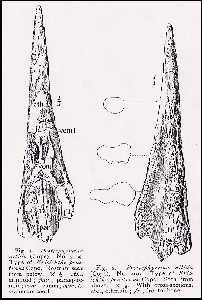 |
LEFT: Fig. 1. Protosphyraena nitida (Cope). No. 2105.
Type of Erisichthe penetrans Cope. Rostrum seen from below. x 1/3. eth.,
ethmoid; par., parasphenoid; vom., vomer; t., vomerine teeth. LEFT:
Fig. 2. Protosphyraena nitida (Cope). No. 2105. Type of Erisichthe
penetrans Cope. Rostrum seen from above. x 1/3. With cross sections. eth.,
ethmoid; f., frontal bone.
RIGHT: Fig. 3. Protosphyraena nitida (Cope). No. 2121. x 1/2. den.,
dentary; pct., fragment of pectoral fin; spl., splenial. |
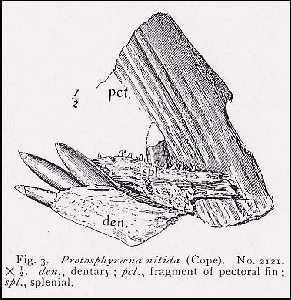 |
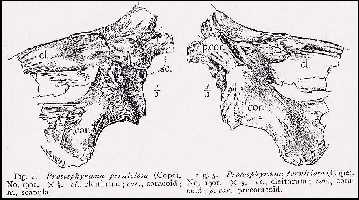 |
LEFT: Fig. 4. Protosphyraena perniciosa
(Cope). No. 1901. x 1/3. cl., cleithrum; cor., coracoid; sc.,
scapula. LEFT: Fig. 5. Protosphyraena perniciosa
(Cope). No. 1901. x 1/3. cl., cleithrum; cor., coracoid; p.cor.,
precoracoid.
RIGHT: Fig. 6. Protosphyraena sp. No. 1646. x 1/3. bas.,
baseosts; cor., coracoid; pct. pectoral fin; sc., scapula.
RIGHT: Fig. 7. Protosphyraena perniciosa (Cope). No. 2009. x 1/3.
Cleithrum seen from inner surface. |
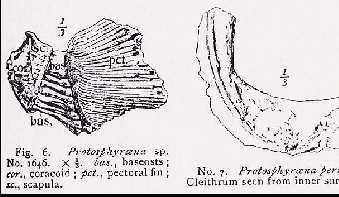 |
| Sometime around 1908, the University of Kansas purchased a Protosphyraena
caudal fin (KUVP-293) that had been discovered by C. H. Sternberg. A short note regarding
the specimen and an illustration were included in McClung (1908). The text, Plate 13
(Left) and a recent photo (Right) are shown below: |
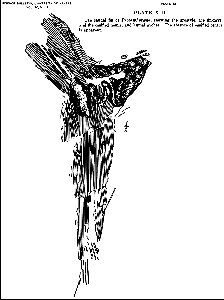 |
M'CLUNG: THE KANSAS CRETACEOUS
245 ...
CAUDAL FIN
OF PROTOSPHYRÆNA.
"The entire skeleton of any member of this genus has
not yet been discovered. There is therefore lacking a knowledge of several portions of the
body, among which are the occipital region of the skull, the vertebral column and the
caudal fin. Light upon all these points is afforded by material now at my disposal. I wish
here to consider the caudal fin and incidentally the vertebræ. Through purchase from Mr.
C. H. Sternberg the University of Kansas has come into possession of a specimen of the
caudal fin, which not only shows the nature of this organ but also clearly demonstrates
the absence of ossified vertebrae. In plate XIII is represented a lateral view of this
specimen, from which the essential features may be understood without much description.
The ossified neurals and hæmals appear very plainly, as they do in the nearly related Hyposocormus,
according to Woodward, but the centra are absent. The last hæmal is considerably
modified, forming a urostyle, to which many of the fin-rays attach. This bone is
frequently found by collectors, but its character and relationships have not heretofore
been understood. The fin-rays are fine, closely apposed and very numerous. In the specimen
under consideration they are incomplete and broken, so that the exact form of the fin
cannot be ascertained. Apparently it was broad and firm."
246
KANSAS UNIVERSITY SCIENCE BULLETIN.
Owing. to the isolated condition of the specimen its
specific position cannot be determined, and any attempt to do this would be only a guess.
It is an important specimen, however, since it definitely places the genus in the family Pachycormidæ,
upon the assumption that only the uncertainty of vertebral characters previously made the
classification doubtful." |
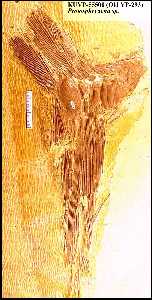 |
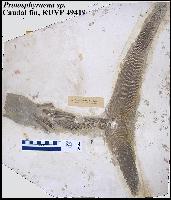 |
LEFT: The tail of Protosphyraena sp. (KUVP 49419) in the
University of Kansas collection; collected from the Smoky Hill Chalk of Trego County. The
upper lobe of the tail is complete; the lower lobe is damaged and incomplete. RIGHT:
A closer view at the same specimen. Note that the centra of the vertebrae of Protosphyraena
are poorly ossified and are not preserved even though the dorsal and ventral processes
are. Protosphyraena has a distinctive bone at the base of the tail
(caudal fin) called the hypural that is sometimes preserved separately. |
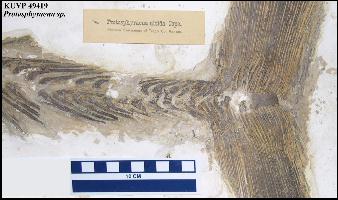 |
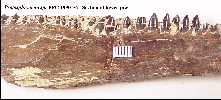 |
(ABOVE) The teeth of Protosphyraena are flat and
blade-shaped, and non-serrated. They are quite unlike any other large teeth found in
the Smoky Hill Chalk. Click HERE and HERE to see other views. (RIGHT) - This section of the
lower jaw of Protosphyraena shows the arrangement of the more posterior teeth. |
Other
Oceans of Kansas webpages on Late Cretaceous fish:
Field Guide to Sharks and Bony
Fish of the Smoky Hill Chalk
Sharks:
Kansas Shark Teeth
Cretoxyrhina and Squalicorax
Ptychodus
Chimaeroids
Bony Fish
Pycnodonts and Hadrodus
Plethodids:
Pentanogmius
Martinichthys
Thryptodus
Bonnerichthys
Protosphyraena
Enchodus
Cimolichthys
Pachyrhizodus
Saurodon and Saurocephalus
Xiphactinus
Suggested references:
Cope, E. D. 1873. [On an extinct genus of saurodont fishes].
Proc. Acad. Nat. Sci. Phil. 24:280-281. (meeting of Dec. 17, 1872) Wherein Cope names of
the genus Erisichthe and describes Erisichthe (Protosphyraena)
nitida). <EM>
Cope, E.D. 1873. On two new species of Saurodontidae. Proc.
Acad. Nat. Sci. Phil. 25:337-339. (naming of Portheus lestrio (Xiphactinus
audax), Portheus gladius (Protosphyraena gladius) and Daptinus
(Saurodon leanus).
Cope, E.D. 1874. Review of the vertebrata of the Cretaceous period found west of the
Mississippi River. U. S. Geol. Surv. Terr. Bull. 1(2):3-48.
Cope, E.D. 1875. The vertebrata of the Cretaceous formations of the West.
Report, U. S. Geol. Surv. Terr. (Hayden). 2:302 p, 57 pls.
Diedrich, C. 2001. Ein pectoralflossenrest von Protosphyraena sp.
(Pachycormidae, Actinopterygii) aus dem Ober-Cenoman von Halle/Westf. (NW-Deutschland).
Ber. Naturwiss. Verein fur Bielfefeld u. Umgegend 41:31-44. (Report of a fairly complete
specimen in Germany)
Friedman, M., Shimada, K., Martin, L., Everhart, M.J., Liston, J., Maltese, A.
and Triebold, M. 2010. 100-million-year dynasty of giant planktivorous bony fishes in the
Mesozoic seas. Science 327:990-993.
Hay, O.P. 1903. On certain genera and species of North American Cretaceous
Actinopterous fishes. Bull. Amer. Mus. Nat. Hist. XIX 1-95, pls. i-v, 72 text-figs.
Hibbard, C.W. 1942 A new chimaeroid fish from the
Niobrara Cretaceous of Logan County, Kansas. University Kansas Science
Bulletin 28-2(11):237-240, 4 fig.
Kear,
B.P. 2007. First record of a pachycormid fish (Actinopterygii: Pachycormiformes) from the
lower Cretaceous of Australia. Journal of Vertebrate Paleontology 27(4):1033-1038.
Leidy, J. 1857. Remarks on Saurocephalus and its allies. Trans. Amer.
Philos. Soc. xi pp. 91-95, with pl. vi.
Loomis, F. B. 1900. Die anatomie und die verwandtschaft der Ganoid-
und Knochen-fische aus der Kreide-Formation von Kansas, U.S.A. Palaeontographica, 46: 213-283,
pl. XIX-XXVII. (in German)
Mantell, G. 1822. The fossils of the South Downs; or illustrations of the
geology of Sussex. Lupton Relfe, London, xiv + 327 p., 42 p. (page 319 and plate 39, first
publication of a drawing the fin of Protosphyraena)
McClung, C.E. 1908. Ichthyological notes on the Kansas
Cretaceous, I. Kansas Univ. Sci. Bull. IV 235-246, pls. x-xiii, 10 text-figs. (SEE ABOVE)
Schultze, H.-P., J. D. Stewart, A. M. Neuner and R. W. Coldiron. 1982.
Type and figured specimens of fossil vertebrates in the collection of the University of
Kansas Museum of Natural History. Part I. Fossil fishes. Misc. Pub. University
Kansas Museum Natural History 73:53 pp.
Stewart, A. 1898. A contribution to the knowledge of the ichthyic
fauna of the Kansas Cretaceous. Kansas University Quarterly 7(1):22-29, pl. I, II. (Portheus
lowii sp. nov., Daptinus broadheadi sp. nov., Saurocephalus
dentatus sp. nov., Protosphyraena bentonia sp. nov., and Protosphyraena, sp. nov.)
Stewart, A. 1899. Notice of three new Cretaceous fishes, with remarks on the
Saurodontidae Cope. Kansas Univ. Quar. 8(3):107-112. (Xiphactinus, Protosphyraena
gigas and Empo [Cimolichthys])
Stewart, A. 1900. Teleosts of the Upper Cretaceous. The University Geological
Survey of Kansas. Topeka 6:257-403, 6 figs., pls. XXXIII-LXXVIII.
Stewart, J.D. 1979. Biostratigraphic distribution of species of Protosphyraena
(Osteichthyes: Actinopterygii) in the Niobrara and Pierre Formations of Kansas.
Proceedings of the Nebraska Academy of Sciences and Affiliated Societies, 89th Annual
Meeting, p. 51-52. (abstract)
Stewart, J.D. 1988. The stratigraphic distribution of late Cretaceous Protosphyraena
in Kansas and Alabama, Geology, In Nelson, M. E. (ed.), Paleontology and
biostratigraphy of western Kansas: Articles in honor of Myrl V. Walker, Fort Hays Studies,
3(10):80-94. (Science)
Stewart, J.D. 1990. Niobrara Formation vertebrate stratigraphy, pages 19-30, In
Bennett, S. C. (ed.), Niobrara Chalk Excursion Guidebook, The University of Kansas
Museum of Natural History and the Kansas Geological Survey.
Taverne, L. 1999. Révision du genre Martinichthys,
poisson marin (Teleostei, Tselfatiirormes) du Crétecé supérior du Kansas (États-Unis).
Geobios 33(2):211-222. (Revision of the genus Martinichthys, marine fish
(Teleostei, Tselfatiiformes) from the Late Cretaceous of Kansas (United States))
Woodward, A.S. 1895. Catalogue of the fossil fishes in
the British Museum. Part 3. British Museum of Natural History, London. Pp.
i-xliii, 1-544, pls.






